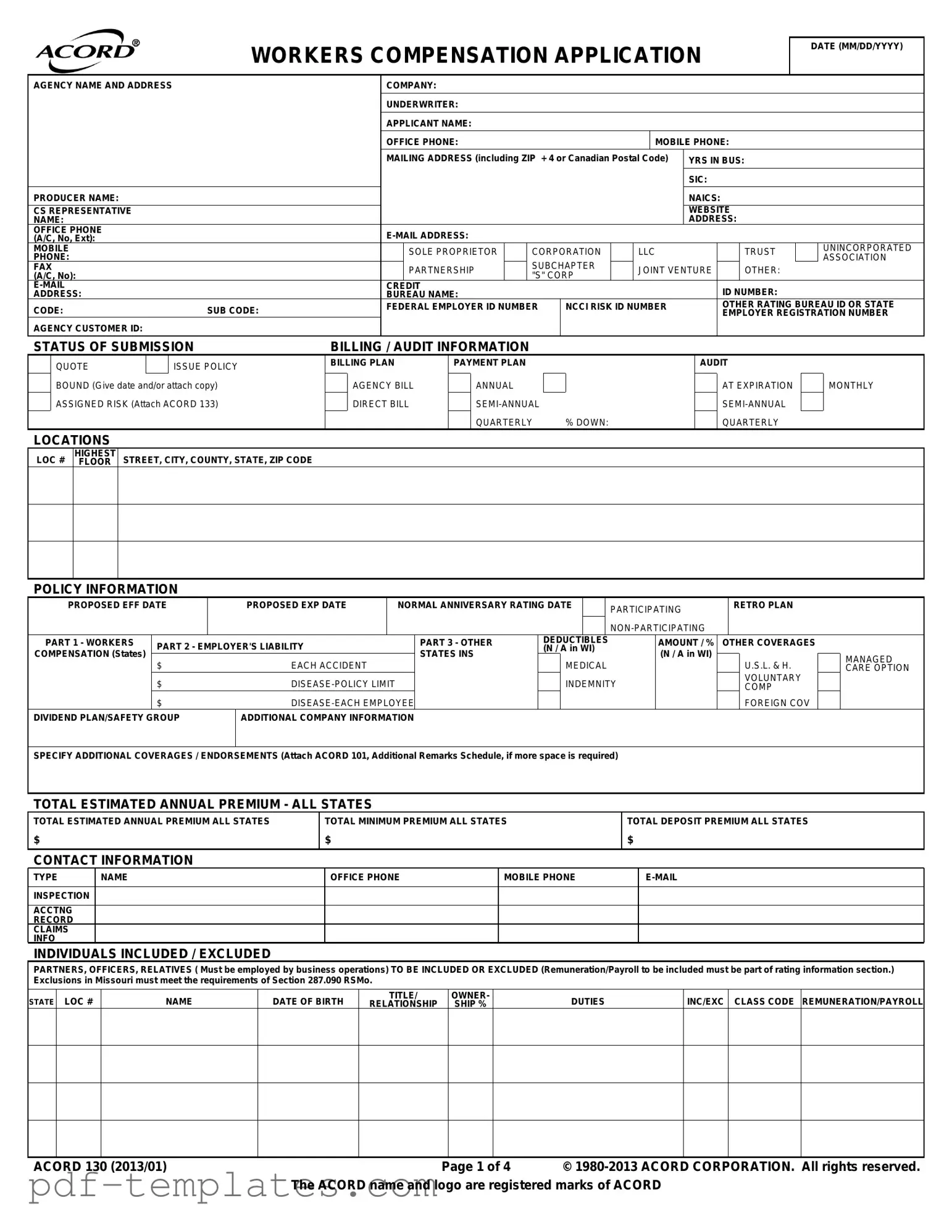The ACORD 125 form is often used alongside the ACORD 130 form in the insurance industry. It serves as a general liability application and provides a comprehensive overview of the insured's business operations. Just like the ACORD 130, it collects essential information about the applicant, including the nature of the business, contact details, and coverage needs. The ACORD 125 focuses more on general liability coverage, while the ACORD 130 zeroes in on workers' compensation, making them complementary documents in the insurance application process.
Another document that shares similarities with the ACORD 130 is the ACORD 133 form, which is specifically designed for assigned risk applications. The ACORD 133 is typically used when a business cannot obtain workers' compensation insurance through the standard market. Like the ACORD 130, it gathers information about the business, its employees, and its operations. Both forms aim to provide insurers with the necessary details to assess risk and determine coverage options, but the ACORD 133 is tailored for situations where standard options are unavailable.
The ACORD 101 form, known as the Additional Remarks Schedule, is also relevant in this context. While the ACORD 130 collects vital information about workers' compensation, the ACORD 101 allows applicants to provide additional details or clarifications that may not fit within the standard form. This document can be attached to the ACORD 130 to enhance the clarity of the applicant's situation, ensuring that all relevant information is available for the insurer's review.
Similar to the ACORD 130 is the ACORD 140 form, which is used for commercial property applications. This form gathers information about the property being insured, including its location, value, and usage. While the ACORD 130 focuses on employee-related risks, the ACORD 140 addresses physical assets. Both forms require detailed descriptions to help insurers evaluate the associated risks, making them essential components of the commercial insurance application process.
In addition to the various ACORD forms discussed, it is crucial for buyers and sellers in Texas to consider utilizing a Texas Vehicle Purchase Agreement, which ensures clarity and legality in vehicle transactions. By documenting the sale terms regarding the vehicle and financial details, both parties are protected. For those looking to create or review such agreements, resources are available at documentonline.org/blank-texas-vehicle-purchase-agreement/, helping to streamline the buying process and mitigate potential disputes.
The ACORD 160 form, which is a Commercial General Liability Application, also bears resemblance to the ACORD 130. It collects information about a business's general liability exposures, such as operations, locations, and coverage limits. While the ACORD 130 is dedicated to workers' compensation, the ACORD 160 aims to address liability concerns. Both forms work in tandem to provide a comprehensive view of a business's risk profile, aiding insurers in making informed decisions.
The ACORD 25 form, known as the Certificate of Liability Insurance, also serves a related purpose. Although it is not an application form like the ACORD 130, it provides proof of insurance coverage for businesses. The ACORD 25 includes details about the type of coverage, limits, and effective dates, similar to the information found in the ACORD 130. While one is an application and the other a certificate, both documents are critical in establishing and verifying insurance coverage for businesses.
Lastly, the ACORD 50 form, which is the Commercial Auto Application, parallels the ACORD 130 in that it gathers specific information related to a different type of coverage. While the ACORD 130 focuses on workers' compensation, the ACORD 50 collects details about vehicles, drivers, and usage. Both forms are necessary for evaluating risk and determining appropriate coverage, ensuring that businesses are adequately protected in various aspects of their operations.
